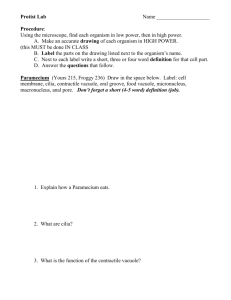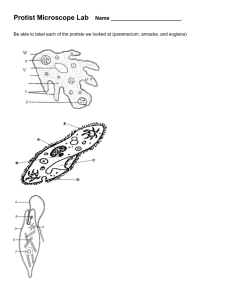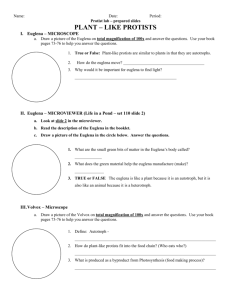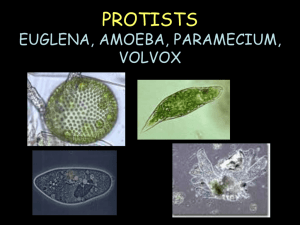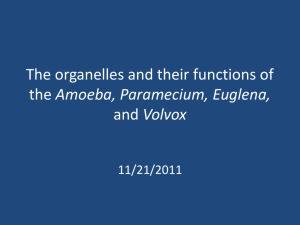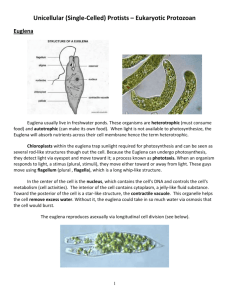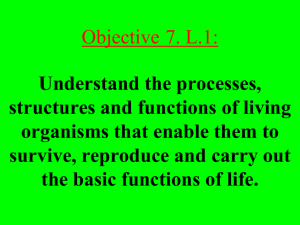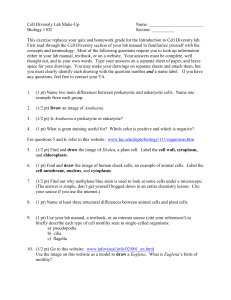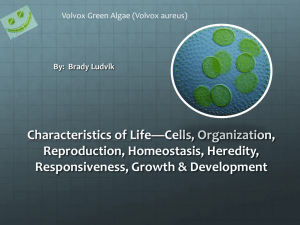Kingdom Protista
advertisement
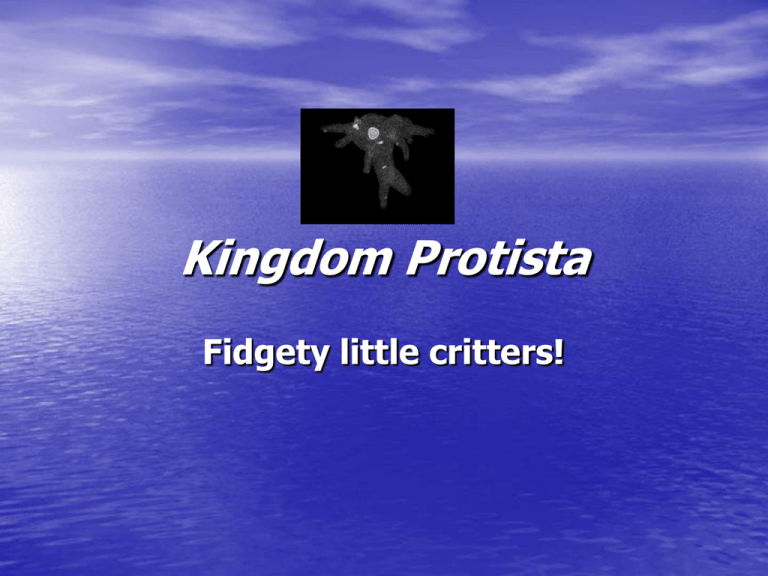
Kingdom Protista Fidgety little critters! What is a Protist? • Eukaryotic – Has a nucleus! • Mostly single celled • Classified by: – MOVEMENT – OBTAIN FOOD • Animal-like: – Heterotrophic • Plant-like: – Autotrophic (have chloroplasts) • Fungus-like: – Parasitic – REPRODUCE Animal-like Protists: Sarcodinia • Movement: – By pseudopods: • Little blobs of cytoplasm • Means “Fake Feet” • Consumer Nutrition: – Surround meal and bring into food vacuole • Phagocytosis! • Reproduction: – Binary Fission • Organism: – Amoeba amoeba Amoeba Animal-like Protists: Ciliates • Movement: – By cilia: • Little “hairs” that beat like oars • Consumer Nutrition: – Food is swept in by cilia to GULLET – Contractile vacuoles collect and “spit out” water • Reproduction: – Binary fission AND conjugation • Organism: – Paramecium caudatum, Stentor coeruleus, Blepharisma Paramecium Stentor Plant-like Protists: Flagellates (Volvox) • Colonial organism: – Hundreds of individual cells “live” together • Movement: – Long, whip-like flagella – Whole colony moves together! • Nutrition: – Autotrophic – Contain chloroplasts! (Hence green color!) • Reproduction: – Binary fission Volvox Euglenophytes: The plant-like animal protist • NO CELL WALL: – Has pellicle • MOVEMENT: – TWO flagella • NUTRITION: – Autotrophic (chloroplasts) – Can be heterotrophic when no sunlight! – Red spot helps organism to find sunlight • REPRODUCTION: – By binary fission • ORGANISM: – Euglena Euglena Helpful Diagrams for Lab Also called eyespot Helpful Diagrams for Lab Volvox Helpful Diagrams for Lab Helpful Diagrams for Lab Stentor Cilia Mouth Gullet Contractile Vacuole Food Vacuole General tips/tricks for success the next 2 days… • Follow ALL microscope rules/techniques you’ve learned! – Focus on low power first with coarse adjustment. – Then switch to higher powers and use fine adjustment. • DO NOT mix the droppers! Only use Euglena droppers for Euglena, etc. • Use same slide and cover slip and keep washing them off and drying them each time you get a new specimen. • BE CAREFUL around the live specimen! Only ONE person per group should be making the slide. Don’t crowd the area and increase the risk of spilling the specimen!! General tips/tricks for success the next 2 days… • The stentor and amoeba: – They are supposed to look like blobs of cytoplasm. – They are NOT the tiny swimming things that you may see around the non-moving blobs. Those are probably some other protozoa like paramecium. • You SHOULD move the slide around on the • stage to “search” for specimen if you don’t see anything at first. Also, some of them are VERY fast. Sometimes you only get a quick glance as they “swim” by. General tips/tricks for success the next 2 days… • If at first you don’t succeed… • It’s OK to go back and try to make another slide of the organism. It is quite possible to get one that does not have any of the organism in it. • REMEMBER, you only need a few drops from the pipette onto the slide, though. General tips/tricks for success the next 2 days… • The volvox are SOOOO cool! They are my • • • favorite! You may want to skip to these first just to ensure a good, LIVE, view of them! You MAY use a textbook for help labeling the diagrams, BUT the best help will be going to my website and using this PowerPoint!! The questions in the lab are easy and only require you to read the paragraphs about each organism.
